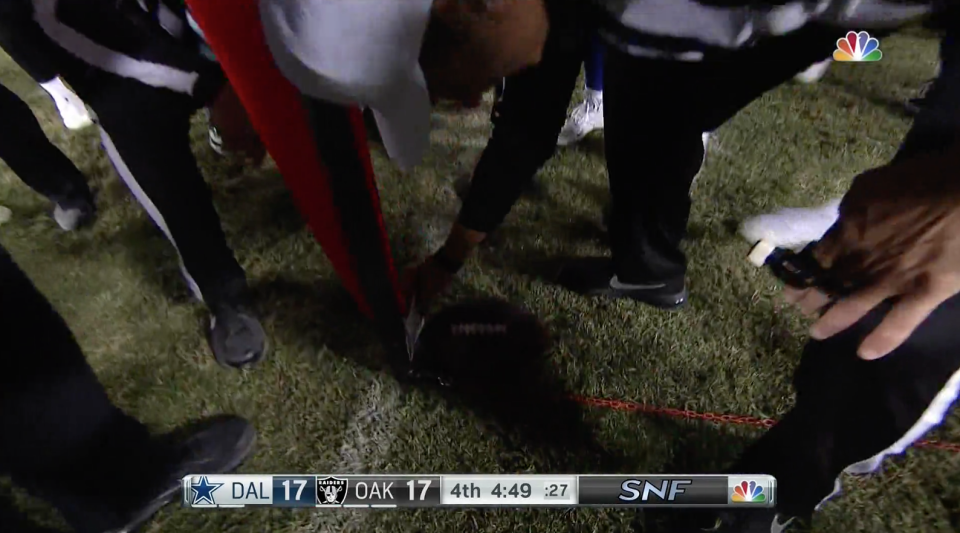Cowboys keep playoff hopes alive on dumbest rule, strangest measurement in football
In a season that’s seen some of the strangest, most absurd moments in the NFL’s entire history, Sunday night’s game, a 20-17 Dallas Cowboys victory over the Oakland Raiders, ended on the dumbest possible note: a ridiculous measurement followed by the return of the most nonsensical rule in football.
Settle in and get a drink; this is going to make you want to throw something.
The scene: Dallas and Oakland were both playing to keep the dying embers of their playoff hopes alive. Late in the fourth quarter, with the score tied at 17, the Cowboys were driving toward what could have been a game-winning score. On a crucial fourth down, Dallas couldn’t push the ball decisively past the first-down marker, and the officiating crew called for a measurement.

Here is where we note that the officiating crew was led by Gene Steratore, who last helmed a Cowboys game when Dez Bryant caught/didn’t catch a crucial playoff pass. That handy little coincidence ought to give you a sense of the strangeness to come.
When the crew brought out the chains, something amazing happened: no one could tell whether the ball had broken the plane necessary to give Dallas a first down. This wasn’t a case of being within a single link of the yardage chain, this was simply too close to call based on the shape of the football, the angle of sight, and the position of the first-down post.
So what did Steratore do? He brought out a folded index card — yes, seriously — and plunged it between the ball and the post. And because the ball moved: first down!
“Bull[expletive]” Raiders coach Jack Del Rio shouted on the sideline, and you can understand why.
“Didn’t use the card to make the final decision,” Steratore told a pool reporter postgame. “The final decision was made visually. The card was used nothing more than reaffirmation of what was visually done.”
An organization worth more than $10 billion is measuring yardage with all the technological sophistication of a kindergartner making a Mother’s Day card. Instead of Oakland getting the ball on the Dallas 40 with more than four minutes remaining, Dallas held onto the ball and, soon afterward, kicked a decisive field goal.
But we’re getting ahead of ourselves. The NFL continues to trot out this goofy little community theater-level production of bringing the chains onto the field even though it could easily use a tennis-style electronic line judge to make the calls. (The technology has existed since the 1970s.) Why? Because the NFL loves the drama of the measurement, the tension that comes with wondering whether that chain will extend past the ball or not. And, like most attempts at drama, it ends up looking ridiculous a lot more than the NFL would want to admit.
Oh, but we were just getting started. After securing that miracle first down, the Cowboys couldn’t push in a touchdown even though they ended up practically breathing into the end zone — could’ve used a paper-width more distance there — and were forced to settle for a field goal. That allowed Oakland to drive back down the field — aided greatly by a 55-yard pass interference penalty, another one of those rules that seems unduly punitive — and get in position for either a game-tying field goal or a go-ahead touchdown.
With 31 seconds left and the ball on the Dallas 7, Oakland Raiders quarterback Derek Carr took the snap, saw no one open, and took off toward the end zone. He extended the ball—because all you’ve got to do as a runner is break that mystical plane of the end zone—but he did so a touch too early, hit the ground, and fumbled forward into the end zone … thus activating the dumbest rule in football, the touchdown-to-touchback. If Carr had fumbled the ball half a foot in to the right, out of bounds, Oakland would have lined up for a first-and-inches. Instead, it was loss of possession, loss of game, loss of playoff hopes.
The NFL now resembles a particularly cranky homeowners’ association annual meeting, with a horde of black-and-white-striped bureaucrats jamming themselves into every possible crevice, arbitrarily applying game-altering rules, claiming they’re trying to eliminate uncertainty and yet doing the exact opposite. When you’ve got retired officials commenting on the officiating brain trust that’s officiating the officiating crew on the ground, it’s maybe possible you’ve gone too far down the rabbit hole.
A receiver now has to provide a notarized proof of legal adoption to confirm a catch. An offensive lineman can remove a kidney from a defender without penalty, but a defender can’t even think angry thoughts about a ballcarrier without drawing a flag. And oh, the challenges, the endless challenges, which apply in every situation except those where they don’t.
Protesting players, angry politicians, troublesome owners, falling ratings and disaffected fans are combining to form an existential problem unlike any the NFL has ever seen, and one the league appears woefully ill-equipped to handle. Given the farce that was the final few minutes of Sunday night’s game — and, we could add, the final seconds of the Patriots-Steelers epic a few hours earlier — it’s not hard to see how the league bureaucratically knotted itself into this mess.
Changing rules from tax code-level complexity to simple common sense won’t get the NFL out of its current morass. But it’ll help make games less like small-claims court and more, you know, fun.
____
Jay Busbee is a writer for Yahoo Sports. Contact him at jay.busbee@yahoo.com or find him on Twitter or on Facebook.
More from Yahoo Sports:
• Refs cost Steelers a win thanks to NFL catch rule
• LeBron sends clear message to President Trump with shoe choice
• NFL Winners and Losers: Tom Brady still the greatest
• Eric Adelson: Cheerleaders’ anthem protest brings major change
